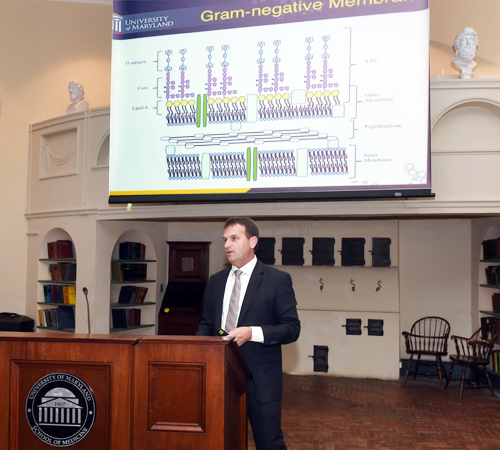Davidge Hall has been witness to some enlightening presentations over its 205 years, but chances are few foes discussed there have been more formidable than sepsis, which Robert K. “Bob” Ernst, PhD, addressed in his Founders Week Researcher of the Year presentation on Oct. 17.
(View a photo gallery.)
A death from sepsis occurs every two minutes in the United States. Hospitals spend $23 billion on it annually, making it the most expensive condition treated in U.S. hospitals.

Robert K. “Bob” Ernst, PhD, professor and vice chair, Department of Microbial Pathogenesis at the University of Maryland School of Dentistry, presented "Structure Matters -- Making Bacterial Molecules Work for Us," in Davidge Hall.
Ernst, professor and vice chair of the Department of Microbial Pathogenesis in the University of Maryland School of Dentistry (UMSOD), and his colleagues are engineering rationally designed mimetics based on bacterial surface molecules that will inhibit the ability of the body to mount the damaging immune response present in sepsis.
In particular, he is at the forefront of innovative research studying the molecular basis by which bacteria modify the lipid component of their membrane, specifically lipopolysaccharide (LPS), and how these alterations affect normal host innate immune system responses, potentially resulting in septic shock.
Before his presentation Ernst was saluted by University of Maryland, Baltimore President Jay A. Perman, MD, and School of Dentistry Dean Mark A. Reynolds, DDS, PhD, MA. “We recognized Dr. Ernst at the Gala Saturday night, but now he needs to work for it,” said Perman, eliciting laughter from the 100-plus Ernst colleagues, students, faculty, and staff on hand. Perman praised Ernst not only for his “groundbreaking body of work” but also as “a generous collaborator, entrepreneur, and very dedicated mentor.”
When Perman spoke of the scientist inspiring the “next generation of Bob Ernsts” an “oh, no” from the crowd brought another round of laughter, with the jovial Ernst leading the way.
Indeed, Reynolds said Ernst’s “enthusiasm for science and mentoring is contagious,” which he showed in his 45-minute presentation “Structure Matters — Making Bacterial Molecules Work for Us.”
Without notes, the award winner chronicled the journey his research has taken. He thanked a long list of collaborators and funders, saying “you can’t just rely on NIH,” which has supported Ernst and his team with $3 million in the last decade. UMB’s seed grant program and MedImmune also have provided strong support.
He discussed E coli, pattern recognition receptors, and the “bar code” in bacterial molecules. “Pathogens are detected by pattern recognition receptors on host cells that recognize structures that are broadly shared by pathogens,” Ernst said. “These bacterial patterns represent a signature or ‘bar code’ that informs the host on the level of danger of the invading organism and how to respond.”
Ernst came to UMB in the fall of 2008, moving his laboratory from the University of Washington in Seattle. David R. Goodlett, PhD, who worked closely with Ernst in Seattle studying the structure function relationships of lipid A, also came to UMB and is now a professor of pharmaceutical sciences in the University of Maryland School of Pharmacy.
In 2016, Ernst and Goodlett co-founded a startup diagnostic company called Pataigin. Last fall, the company received a $25,000 Maryland Department of Commerce Life Award for its patented test called “BACLIB” that inexpensively identifies bacteria- and fungi-causing infections in less than an hour, allowing clinicians to make decisions in the hospital at the “point-of-care.”
“Thank you to Jim Hughes and the UMB tech transfer office for all their help,” Ernst said.
When he turned to sepsis, Ernst’s tone turned more serious. “Each hour delay in antibiotic treatment the mortality rate goes up 7 percent,” he said.
Ernst admits he’s willing to talk to anyone in his quest for research advances. That approach has taken him to Maastricht in the Netherlands to utilize multimodal imaging, tracking where the blood flow is in sepsis. “They’re among the best in the world, with an image every 20 minutes instead of every three to six hours.”
Ernst was the picture of a passionate scientist, enthused and lifted when he discussed advances with E coli and the LPS, bemoaning the setbacks, praising “unheard of” assistance from the Food and Drug Administration, and recognizing his colleagues in the professional schools at UMB.
“Absolutely, this is the most collegial university that I’ve been associated with. The Department of Microbiology and Immunology in the School of Medicine and our department work together hand in glove. We are now branching out to do work with cancer researchers at UMB, MedImmune, and the National Cancer Institute, as they are also looking for novel mechanisms to attack cancer cells in the body.”
Ernst concluded his presentation with thanks to his many colleagues and a final PowerPoint slide:
Yes, structure does matter
Modulation of the host innate and adaptive immune systems
– Adjuvant development
Just the tip of the iceberg
– We are expanding our library rapidly
– We’ve neglected the carbohydrate portion – core and O-antigen
The potential for a novel antisepsis therapeutic is promising
– Inhibiting at the earliest intervention point
Asked earlier if a cure for sepsis in his lifetime is a realistic possibility, Ernst responded, “Cure, no, there will always be infections. But being able to modify the host response to give physicians a better chance to treat the symptoms associated with sepsis, potentially.”


